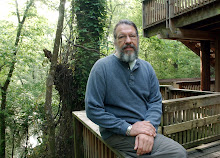Uncertain is perched on the western "shore" of Caddo Lake, a 40,000+ acre lake/cypress swamp complex that straddles the Louisiana-Texas line just above Shreveport. The origin of the name "Uncertain" is, uh...uncertain. Some say it was originated by the U.S. Postal Service as a best-fit designation for the site, where postmen simply dumped mail addressed to various of the swamp rats inhabiting the unreachable upper reaches of the adjacent swamp. In the opening pages of Recipes from Uncertain Cooks, an extra-fine little cookbook put out by members of the Church of Uncertain (a sincerely appropo name for a church, non?) mention, four additional how-Uncertain-got-its-name theories are presented, including 1) steamboat captians plying the waters of Caddo Lake were UNCERTAIN if they were in Texas or Louisiana, 2) there was an UNCERTAIN hunting/fishing lodge near the present location of Uncertain, which was somewhat of a landmark, 3) during a local election to determine if the area was to be "wet" or "dry," the outcome was UNCERTAIN, and 4) akin to the postal service theory, when the city charter was mailed to Austin for name selection, the blank for the name of the city was filled in with "UNCERTAIN".
Cross a tiny bridge east out of Uncertain and you're on Taylor Island, a 70+ acre sand mound rising up from surrounding swamp -- which is where Larry Amy, Kevin Courville, and i spent 6 luxorious days of music-making, fishing, cooking, silliness, and generalized R&R, in a pleasantly-rickety old camphouse named "duckweed," which, without further elucidation, appropriately described our day-to-night-to-day-again agenda for the trip.
a view out of camp duckweed's back porch
back gallery of camp duckweed, where we spent the majority of our time (for those into deeper states of relaxation, there's even a day-bed up in there)
Larry, the trip's techno dude, quickly set up a recording studio there on the back gallery of Duckweed. Daily sessions came like clockwork: 7:30am, 2:30pm, and 8:00pm. In between, we fished, cooked, and laughed -- hard.
There's so much to say about Caddo Lake that it's truly hard to know where to begin. For starters, a little ecological profile: Though many of the old-timers swore that Caddo Lake was formed by the same (1911-12) New Madrid earthquake series that formed Reelfoot Lake in Tennessee, it's pretty apparent by now that it was scoured out by numerous overwash floods from the nearby Red River -- particularly those floods occurring after the formation of the massive 130 mile log jam on the Red River that stretched from present-day Caddo Lake, south to nearly Natchitoches, and before Henry Shreve dismantled the jam in 1873. So it's a pretty recent thing, y'know.
Much of the Louisiana side of Caddo Lake consists of open water, dotted here and there with old cypresses. Most of the Texas side of the lake is not really a lake at all, but a massive, old-growth cypress-tupelo gum swamp, crisscrossed by hundreds of bayous, bayoulettes, sloughs, ponds, what-have-you. The shorelines of the swamp support cool vegetation such as American snowbell (Styrax americana), buttonbush, river birch, and swamp privet. Cardinal flower (Lobelia cardinalis; in full bloom during our stay) dotted the dry swamp floor in numerous places. In every snippet of open water, no matter how small, aquatic vegetation covers the water in lush abundance; dominated by American lotus, water lily, and spatterdock.
above, water lily (Nymphaea odorata) below, spatterdock (Nuphar advena)
Numerous sandy hillocks arise around the perimeter of the entire complex, some forming islands, some remaining on the mainland. Lower elevations of the hillocks support bottomland hardwood forest vegetation including delta post oak, green ash, sweetgum, persimmon, hackberry, and American elm. Tying both the swamps and the lower elevation forests together is spanish moss -- more spanish moss than you've probably ever seen before -- casting a gauzy veil over everything. It's like you're dreaming thru a smokey gray haze all the livelong day. "Disneyesque" was what blurted out of my mouth, first time i saw it. Which is whacky, y'know, in that the scene is anything but Disneyesque. It's real all right, and it's in our face everywhere you travel by water.
If any of you have wondered what the Atchafalaya Basin might have looked like before it was stripped of its timber in 1875-1930, go ahead and have a look at Caddo Lake.
Kevin, feverishly documenting moss . . .
By mid-slope, the forest morphs into a pine-oak-hickory affair, featuring massive specimens of loblolly pine, black gum (Nyssa sylvatica), mockernut hickory, and several oak species. The very tops of the hillocks, called "glades" by the locals, featured a full-blown. dry-mesic, post-oak savannah habitat type.
Thus, almost wherever you go, you have at least 4 major habitat types to explore -- all neatly stacked for your convenience. Birdwise, i honestly thought we'd see more than we did, given we stayed there during the near-peak of fall migration. We saw a good number of birds, though; the most impressive being white-breasted nuthatch (in Louisiana, common only around Shreveport), which apparently lives up in the higher-elevation hardwoods on a year round basis.
Next post: Word sketches of the weird, whacky, wonderful, controversial cultural history of Caddo Lake.








I picked the wrong time frame to lead a field trip...... I'm not up there until tomorrow, Field trip in the state park, fall color on paw paw, lady slipper's, sassafras, oaks, elms and ect....... and lunch..... Well Shady Galde is the plan..... Well written Big Daddy!!!!!!
ReplyDeleteThat sounds like a wonderful LATEX destination.
ReplyDeleteEnjoyed reading about yur travels.